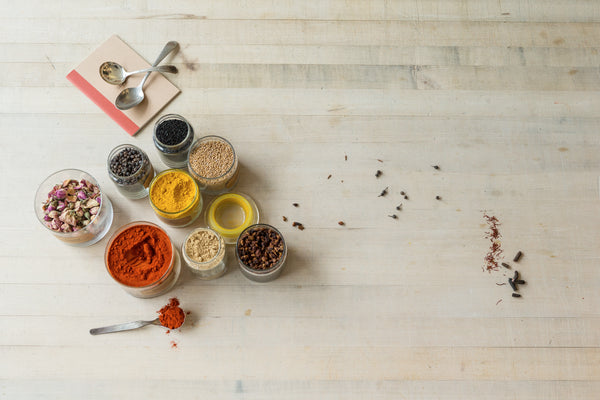
Spice Storage & Organization
If you are going to go through the effort of making your own spice blends or buying high quality spices, you should know how to properly store them! Proper storage leads to longer lasting spices. Whether its whole spices, ground spices or spice blends, always try to keep them out of direct sunlight, in a cool, dry area of your kitchen. Don't keep your spices on a sunny windowsill or near the oven.
It's important to note that spices rarely ferment or spoil, so old spices shouldn't make you sick. However, old spices don't retain their flavors and smells, so there is no use in keeping them. It's best to throw out spices that have lost their smell and color and buy new ones.

Here are some tips and tricks to ensure that you are properly storing all of your spices:
1. The Container
Spices should be kept in airtight containers to keep the moisture out. Humidity can lead to lumps in your spices and also lead to mold on chili flakes. Garlic and onion also have a chance of fermenting when exposed to moister. Also make sure that your spice containers don't conduct heat or react to the spice. Any change in heat can cause loss of scent and flavor.
We recommend getting containers that are easy to clean and look good in your kitchen. They should fit your cooking style and needs. Here are the pros and cons of different container styles:
Glass
Pros: Glass is a very good option for storing spices because it doesn't react to ingredients, unlike some kinds of plastics and woods. Glass doesn't typically conduct heat and you can see what's inside to keep track of inventory. We like glass containers because they are easy to clean and they also look great sitting on a countertop.
Cons: There is a risk of breakage and exposure to light. So, if you decide on glass jars for your spice storage, be sure to keep them out of reach of children and away from direct sunlight!
Plastic
Pros: Low risk of breakage and if the plastic is opaque, there is no concern over light exposure.
Cons: There are certain types of plastic containers that can react to the acidity found in spices, which can end up dissolving or eating away at the plastic material. Not all plastics at BPA-free and unless it's a clear jar, you will have to open to see what's inside.
If you decide to go with opaque plastic containers, be sure to properly label the jars and to make sure that the plastic won't react with the spices.
Metal
Pros: Metal is easy to clean and doesn't react with spices. It also doesn't retain any odors. Metal containers don't break and there is no risk of light exposure.
Cons: It conducts heat and there is no ability to keep track of inventory unless you open the jar. If you decide to go with metal spice jars, keep them away from heat and label them properly.
Wood
Pros: No risk of breakage or exposure to light and it is rare that wood will conduct heat.
Cons: Wood is porous, so there's a good chance that humidity will seep through. Spices may also react with the wood material and make it hard to clean the containers. There is also no way to see inside the jar without opening it.
While wood might be an attractive vessel for spice, we do not recommend that you use wood jars for your spices.
Plastic Bags
Pros: They take up very little space because they lay flat and can be stacked.
Cons: They oftentimes don't seal well, risking moisture getting in. Plastic bags also risk light exposure and because they can't stand on their own, they might not be practical for the kitchen.

2. Refrigeration & Freezing
While we recommend keeping your spices at low temperatures to increase their shelf life, if stored incorrectly in the fridge or freezer, there is a risk of humidity getting in. Also, storing spices along with other food products may impart unwanted smells onto your food or the other way around. It is not recommended to keep spices in the fridge or freezer, but if you must, storing them in an airtight container is essential.

3. Labeling
Labeling your spice containers should be a standard because spices and spice blends can often look similar to each other. You can go a step further and add the purchase date to your labels. This will give you a better idea of when it's time to throw out your spices and buy new ones. If you want to get very meticulous, you can even add the country of origin. Spices like oregano and cumin grow in more than once place and should be kept separated based on country of origin because they taste different.

4. Spice Racks & Displays
Where you store your spices and how you organize them is really a personal decision, but there are a few things you should consider. First, pre-filled spice racks should be avoided. It's hard to tell how old the spices in them are and when they were packages. It's best to buy an empty one and fill it with newly dried or freshly purchased spices. We like to keep our spices out on the counter or mounted to the wall (using our spice boxes) so that you can see them. Keeping them in your line of sight while cooking makes them more accessible and more likely that you will use them.


